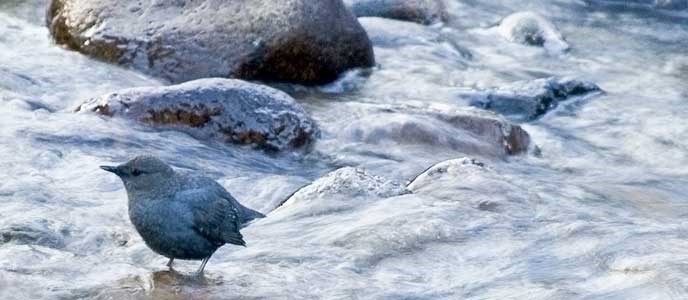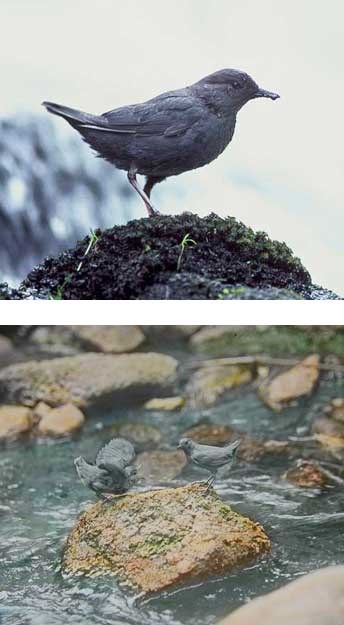
NPS 
Bottom: American Dippers are named for the dipping action they perform. Photo Courtesy of U.S. Fish and Wildlife Service Cinclus mexicanusLength: 5.5-7.9 in (14-20 cm) - Weight: 1.5-2.4 oz (43-67 g) General DescriptionThe American Dippers, formerly known as Water Ouzels, are solid gray birds with slightly browner heads. Their beaks and eyes are dark, and their legs and feet light gray. They have short tails that are often cocked up. Dippers have white upper eyelids that are evident when they blink. Males and females look very similar. Juveniles look like adults but may have white-tipped feathers. HabitatAmerican Dippers are typically found near mountain streams within forested zones. They favor rocky substrates and clear, cold water. They can be found down anywhere from sea level up to alpine zones, as long as there are near suitable streams. Dippers also occasionally inhabit ponds or lake edges, or quiet sections of streams. During winter, they may show up in unusual habitats, but will most always be found in or near water. BehaviorThe name "Dipper" refers to their behavioral characteristic of bobbing. They duck their heads into the water, often up to 60 times per minute. Dippers catch most of their food under water, and jump or dive into frigid water to forage. They walk, heads submerged, along river bottoms, moving rocks to find prey underneath. The dipper takes prey from the water's surface while swimming, and will even use its wings to swiftly move underwater. The Dipper is also capable of flying through waterfalls. These birds are generally solitary and defend both summer and winter territories. The sounds of the American Dipper are very loud and can be heard over the sound of rushing water. These birds molt their wings and tail feathers all at once in the late summer and during this time the bird is flightless. DietThe primary diet of the American Dipper includes small aquatic insects, fish eggs and very small fish. During the salmon spawning season, Dippers are often found in spawning areas. NestingDippers are usually monogamous, but polygamy can occur. Nesting sites are usually what limits breeding, so a male with a territory that includes two appropriate nest sites may mate with two females. In previous years, Dippers have been known to nest on ledges or banks along the sides of streams or behind waterfalls. Most recently, nests are also found under bridges. The females choose the nest site, and both members of the pair help build the nest, often dipping the nesting material in the water before adding it to the nest. Inside the nest is a cup made of grass, leaves, and bark strips while the outside is covered in moss. With the American Dippers living so close to a water source, the spray from the stream keeps the moss alive that covers their nests. Eggs & IncubationAmerican Dipper eggs are white without markings. The female will incubate between three to five eggs for 13 to 17 days while the male provides the food. Once the young hatch, the female broods them for about a week, and then joins the male in providing food for them. The young leave the nest between 24 to 26 days, and can swim and dive immediately after leaving the nest. The parents will often split up the brood and continue to feed the young for up to 24 days after they leave the nest. Migration StatusAmerican Dippers are typically non-migratory, unless the water source they inhabit freezes. If that happens, they will travel short distances into the lowlands to find a new stream for the winter. Interesting FactTo survive in cold waters during the winter, the American Dipper has a low metabolic rate, extra oxygen-carrying capacity in its blood, and a thick coat of feathers.
1
|
Last updated: May 4, 2018
